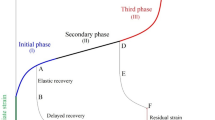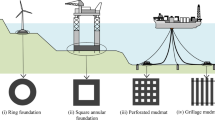Abstract
To study fracture properties and establish a shear–softening constitutive law for rock–concrete interfaces, direct tension, three-point bending, and single shear push-out tests were conducted on composite rock–concrete specimens with different degrees of interface roughness. The relationships between tensile strength (ft), average shear strength (τav), initial fracture toughness (Kini 1C), mode I fracture energy (GIf) and interfacial roughness were determined based on experimental results. A shear–softening constitutive law for rock–concrete interface was developed by measuring strain variations on rock surfaces under loading stages during single shear push-out tests and defined based on shear strength (τmax) and mode II fracture energy (GIIf). For practical applications, the relationships between τmax and ft and between GIf and GIIf were determined by statistically fitting the experimental data in such a way that shear–softening constitutive law could be conveniently determined simply by measuring ft and GIf parameters of rock–concrete interface. Also, numerical simulations were carried out to investigate crack propagation in rock–concrete interfaces under mixed mode I–II fractures. Predicted load versus crack mouth opening displacement (CMOD) curves agreed well with experimental findings and verified the shear–softening constitutive law for rock–concrete interfaces obtained in this study.

















Similar content being viewed by others
Data Availability
The datasets used or analyzed during the current study are available from the corresponding author on reasonable request.
Code Availability
Not applicable.
Consent for Publication
All authors consent for publication.
Abbreviations
- FPZ:
-
Fracture process zone
- FCM:
-
Fictitious crack model
- COD:
-
Crack opening displacement
- CSD:
-
Crack slip displacement
- ENF:
-
End-notched flexure
- ELS:
-
End loaded split
- SSP:
-
Single shear push-out
- DT:
-
Direct tension
- TPB:
-
Three-point bending
- CMOD:
-
Crack mouth opening displacement
- PVC:
-
Polyvinyl chloride
- SIFs:
-
Stress intensity factors
- w :
-
Crack opening displacement
- w s :
-
Crack slip displacement
- σ :
-
Tension stress
- τ :
-
Shear stress
- E :
-
Young’s modulus
- v :
-
Poisson’s ratio
- f t :
-
Uniaxial tensile strength
- f c :
-
Uniaxial compressive strength
- \(K_{{1{\text{C}}}}^{{{\text{ini}}}}\) :
-
Initial mode I fracture toughness
- \(K_{{2{\text{C}}}}^{{{\text{ini}}}}\) :
-
Initial mode II fracture toughness
- G If :
-
Mode I fracture energy
- P max :
-
Peak load
- A :
-
Interfacial area
- τ av :
-
Interfacial average shear strength
- δ x :
-
Relative crack displacements along horizontal x directions
- δ y :
-
Relative crack displacements along vertical y directions
- K 1 :
-
Interfacial SIFs of mode I
- K 2 :
-
Interfacial SIFs of mode II
- \(K_{{1}}^{{{\text{ini}}}}\) :
-
Interfacial SIFs of mode I caused by the initial cracking load
- \(K_{{2}}^{{{\text{ini}}}}\) :
-
Interfacial SIFs of mode II caused by the initial cracking load
- R a :
-
Roughness degrees
- t :
-
Rock block thickness
- L :
-
Bonding length between rock and concrete
- q :
-
Linear load applied on the top of rock block
- σ y :
-
Stress along y-axis
- σ x :
-
Stress along x-axis
- τ xy :
-
Shear stress along x–y plane
- Ф :
-
Stress function
- F y :
-
Forcing function
- ε y :
-
Strain along y-axis
- γ xy :
-
Shear strain along x–y plane
- τ max :
-
Average peak shear stresses
- ΔL :
-
Distance between the midpoints of two adjacent strain gauges
- δ s :
-
Average slip displacement
- δ s1 :
-
Crack slip displacement at the intersection point of bilinear relationship
- δ s0 :
-
Stress-free crack slip displacement
- δ e :
-
Elastic deformation
- δ p :
-
Plastic deformation
- w s :
-
Fracturing displacement
- w s0 :
-
Stress-free crack slip displacement
- w s,ini :
-
Crack opening displacement corresponding to shear stress initiation
- G IIf :
-
Mode II fracture energy
- l ch :
-
Characteristic length for mode I fracture
- l ch-II :
-
Characteristic length for mode II fracture
- K IC :
-
Critical fracture toughness of mode I
- K IIC :
-
Critical fracture toughness of mode II
- \(K_{1}^{P} ,K_{2}^{P}\) :
-
SIFs of modes I and II caused by external loading
- \(K_{{{1}}}^{{{{\sigma ,\tau }}}}\),\(K_{{{2}}}^{{{{\sigma ,\tau }}}}\) :
-
SIFs of modes I and II caused by cohesive tensile stress σ and shear stress τ
References
Ali-Ahmad M, Subramaniam KV, Ghosn M (2006) Experimental investigation and fracture analysis of debonding between concrete and FRP sheets. J Eng Mech 132(9):914–923
Bažant ZP, Pfeiffer PA (1986) Shear fracture tests of concrete. Mater Struct 19(2):111–121
Bouazaoui L, Li A (2008) Analysis of steel/concrete interfacial shear stress by means of pull out test. Int J Adhes Adhes 28(3):101–108
De Moura MFSF, De Morais AB (2008) Equivalent crack based analyses of ENF and ELS tests. Eng Fract Mech 75(9):2584–2596
Dong W, Yang D, Zhang B, Wu Z (2018) Rock–concrete interfacial crack propagation under mixed mode I–II fracture. J Eng Mech 144(6):04018039
Dong W, Zhou X, Wu Z (2013) On fracture process zone and crack extension resistance of concrete based on initial fracture toughness. Constr Build Mater 49(6):352–363
Dong W, Wu Z, Zhou X, Wang C (2016a) A comparative study on two stress intensity factor-based criteria for prediction of mode-I crack propagation in concrete. Eng Fract Mech 158:39–58
Dong W, Wu Z, Zhou X (2016b) Fracture mechanisms of rock–concrete interface: experimental and numerical. J Eng Mech 142(7):04016040
Dong W, Wu Z, Zhou X, Dong L, Kastiukas G (2017) FPZ evolution of mixed mode fracture in concrete: experimental and numerical. Eng Fail Anal 75:54–70
Gálvez JC, Cendón DA, Planas J (2002) Influence of shear parameters on mixed-mode fracture of concrete. Int J Fract 118(2):163–189
Ghorbani M, Mostofinejad D, Hosseini A (2017) Experimental investigation into bond behavior of FRP-to-concrete under mixed-mode I/II loading. Constr Build Mater 132:303–312
Hans WR, Hans AWC, Dirk AH (1986) Tensile tests and failure analysis of concrete. J Struct Eng 112(11):2462–2477
Hillerborg AE, Modéer ME, Petersson PE (1976) Analysis of crack formation and crack growth in concrete by means of fracture mechanics and finite elements. Cem Concr Res 6(6):773–781
Kishen JMC, Saouma VE (2004) Fracture of rock–concrete interfaces: laboratory tests and applications. ACI Struct J 101(3):325–331
Lin JP, Wu YF (2016) Numerical analysis of interfacial bond behavior of externally bonded FRP-to-concrete joints. J Compos Constr 20(5):1–15
Lukić B, Forquin P (2016) Experimental characterization of the punch through shear strength of an ultra-high performance concrete. Int J Impact Eng 91(5):34–45
Nagashima T, Omoto Y, Tani S (2003) Stress intensity factor analysis of interface cracks using X-FEM. Int J Numer Method Eng 56(8):1151–1173
Petersson PE (1981) Crack growth and development of fracture zones in plain concrete and similar materials. Lund Institute of Technology, Lund
Shi Z (2004) Numerical analysis of mixed-mode fracture in concrete using extended fictitious crack model. J Struct Eng 130(11):1738–1747
Silva FGA, Morais JJL, Dourado N, Xavier J, Pereira FAM, De Moura MFSF (2014) Determination of cohesive laws in wood bonded joints under mode II loading using the ENF test. Int J Adhes Adhes 51:54–61
Slowik V, Kishen JMC, Saouma VE (1998) Mixed mode fracture of cementitious bimaterial interfaces, Part I: experimental results. Eng Fract Mech 60(1):83–94
Sujatha V, Kishen JMC (2003) Energy release rate due to friction at bimaterial interface in dams. J Eng Mech 129(7):793–800
Wittmann FH, Rokugo K, Brühwiler E, Mihashi H, Simonin P (1988) Fracture energy and strain softening of concrete as determined by means of compact tension specimens. Mater Struct 21(1):21–32
Wu YF, Jiang C (2013) Quantification of bond–slip relationship for externally bonded FRP-to-concrete joints. J Compos Constr 17(5):673–686
Xu S (2011) Concrete fracture mechanics. Science Press, Beijing (in Chinese)
Xu S, Reinhardt HW (1999) Determination of double-k criterion for crack propagation in quasi-brittle fracture—Part II: analytical evaluating and practical measuring methods for three-point bending notched beams. Int J Fract 98(2):151–177
Yang S, Song LI, Li ZHE, Huang S (2009) Experimental investigation on fracture toughness of interface crack for rock/concrete. Int J Mod Phys B 22(31–32):6141–6148
Yang S, Chen Y, Du D, Fan G (2016) Determination of boundary effect on shear fracture energy at steel bar–concrete interface. Eng Fract Mech 153:319–330
Zhong H, Ooi ET, Song C, Ding T, Lin G, Li H (2014) Experimental and numerical study of the dependency of interface fracture in concrete-rock specimens on mode mixity. Eng Fract Mech 124–125:287–309
Acknowledgements
The authors gratefully acknowledge the financial support of National Natural Science Foundation of China under Grant Numbers NSFC 51478083 and NSFC 51878117.
Author information
Authors and Affiliations
Contributions
WD: Validation, Writing-original draft, Supervision, Project administration, Funding acquisition. ZW: Conceptualization, Methodology. BZ: Data curation, Writing-review and editing. JS: Formal analysis, Investigation.
Corresponding author
Ethics declarations
Conflict of interest
The authors declared that they have no conflicts of interest to this work. We declare that we do not have any commercial or associative interest that represents a conflict of interest in connection with the work submitted.
Ethical Approval
Not applicable.
Informed Consent
All authors consent to participate.
Additional information
Publisher's Note
Springer Nature remains neutral with regard to jurisdictional claims in published maps and institutional affiliations.
Rights and permissions
About this article
Cite this article
Dong, W., Wu, Z., Zhang, B. et al. Study on Shear–Softening Constitutive Law of Rock–Concrete Interface. Rock Mech Rock Eng 54, 4677–4694 (2021). https://doi.org/10.1007/s00603-021-02536-6
Received:
Accepted:
Published:
Issue Date:
DOI: https://doi.org/10.1007/s00603-021-02536-6




